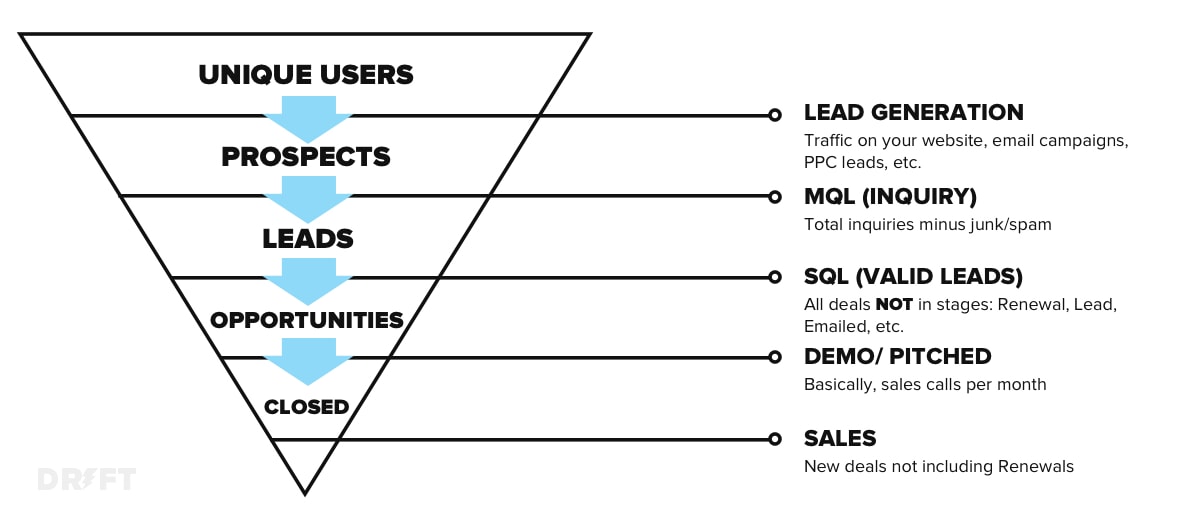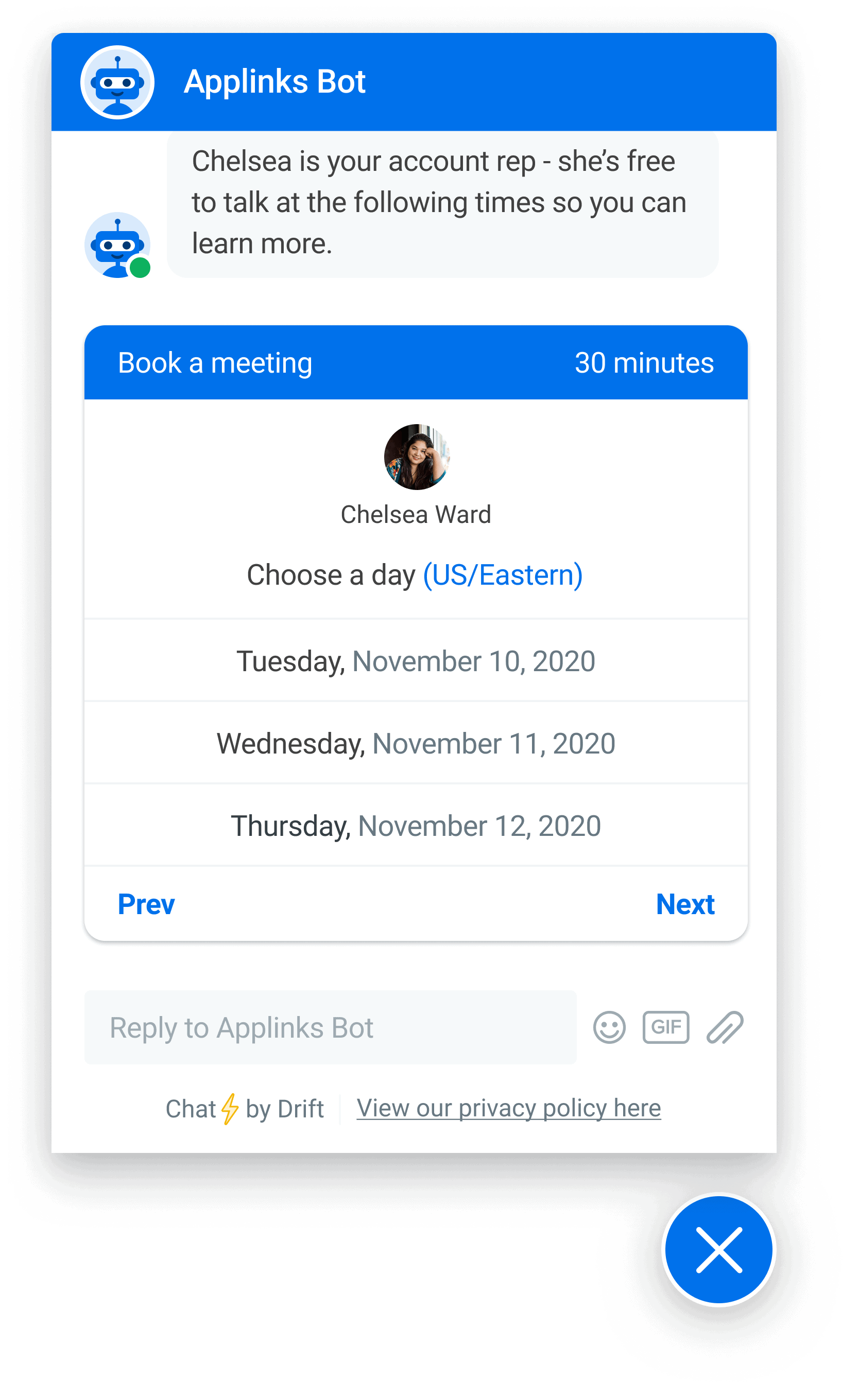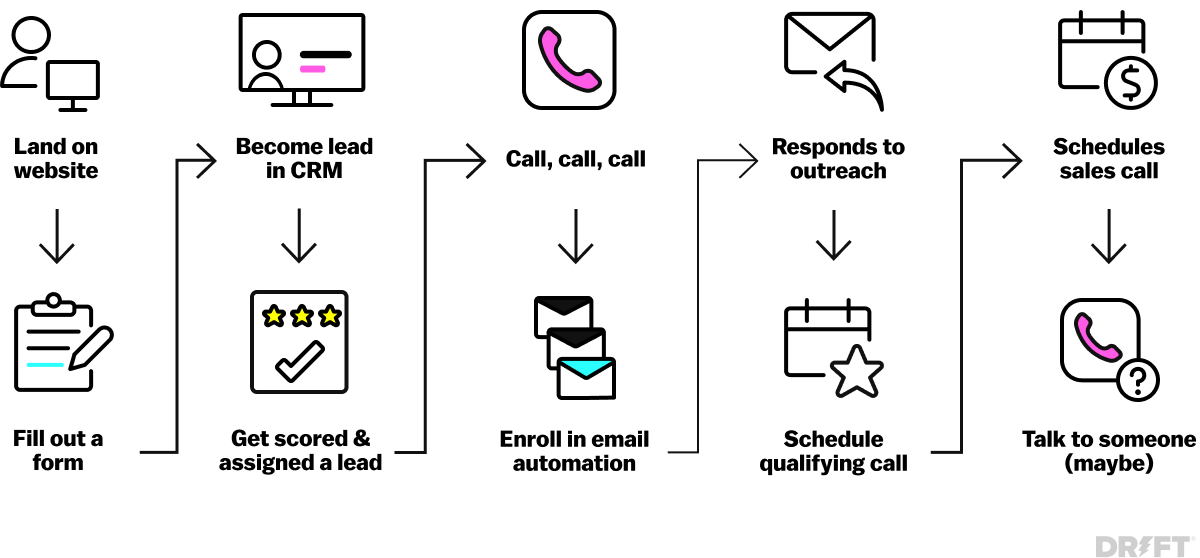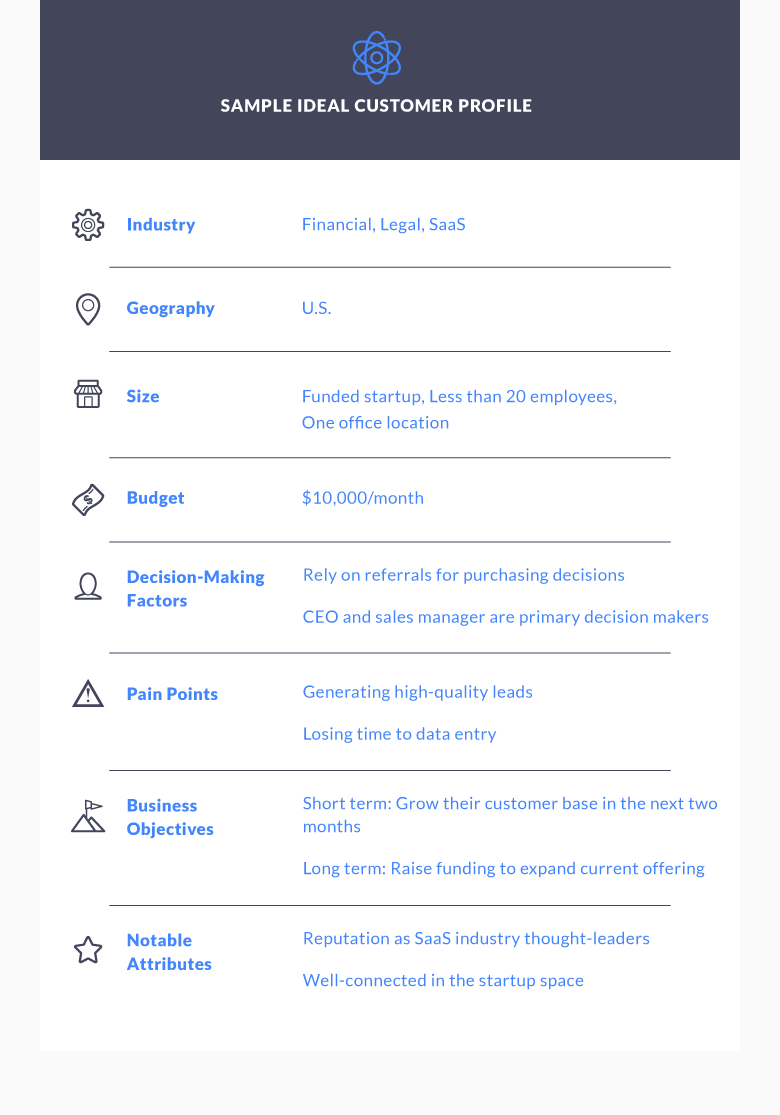Inbound Sales
Read this informative guide to be an inbound sales master. We cover every aspect of inbound selling, from best practices to application.
The complete guide to inbound sales
There was a time when sales was all about the hard sell.
Sales reps would spend their days cold calling or sending out bulk emails.
Then, the buying process changed.
Customers started saying no to old-school sales tactics, and yes to building relationships with the companies they were buying from. So, the industry moved towards a different way of selling – Inbound Sales.
And guess what? It works in a completely different way than the old-school way of selling. Instead of hunting down customers in a phonebook, inbound sales shines the focus on the leads which come to you. Reps can then spend their time finding out what their customer’s pain points are and building up trust around their product.
No spam. No sales tactics. Just winning deals by solving a customer’s problems.
In this piece, we’re going to look at:
- What is inbound sales?
- Inbound sales vs inside sales: what’s the difference?
- Why inbound sales matters
- How inbound sales is changing
- Inbound sales: A 4-step plan to doing it right
- Common mistakes sales reps make with inbound sales
Ready to sell?
What is inbound sales?
Inbound sales is a modern sales framework that creates personalized buying experiences for a company’s customers.
Instead of focusing on selling products, inbound sales reps turn the spotlight onto their customer’s needs and fixing their pain points. Because of this, inbound sales has transformed the way we sell to customers and has changed the traditional buying journey.
A buyer’s journey on the inside sales path has three core stages:
- Awareness of a problem
- Consideration of various solutions
- Decision on a specific solution

Source: HubSpot
Let’s unpack what those three stages mean for salespeople.
In Inbound sales, leads move through several qualification stages before becoming customers. They become aware of your product through channels like blog posts, social media or white papers. Then, they’ll consider whether your product is right for them based touchpoints like videos, guides, or case studies. Finally, they’ll decide to purchase your product after a guided demo or a follow-up phone call.
This method of selling couldn’t be more different from the old school methods of cold calling or sending bulk emails, hoping a lead will bite?
Instead of pushing a sale on a prospect, sales reps use the inbound methodology to nurture customers into making their purchasing decision.
Remember – nobody likes being sold to, but everybody likes to buy. And that’s what makes inbound selling the perfect way to land more business.
Ultimately, your prospects make up their mind whether or not your product is a good fit for them. Through this approach, reps cut down on rejection when prospecting and focus on selling to people who want their product.
Inbound sales vs inside sales: What’s the difference?
A lot of people think inbound sales and inside sales are the same thing. But they’re actually super different. Let’s set the record straight.
The easiest way to describe inside sales is that it’s remote sales. It’s when your products or services are sold through phone, email, or the internet – not in person. Any sale that’s closed virtually or remotely is an inside sale.
And as the sales environment continues to change, it’s essential to highlight the role inside sales is having. According to Sales Benchmark Index, 70% of customers don’t even want to meet with a sales rep in person before making a buying decision. They’re happy cutting checks and signing deals remotely.
Inside sales has muscled its way into serving larger customers with complex needs. Also, inside salespeople who once performed only simple tasks (generating leads, getting renewals) are doing more complex steps, including assessing customer needs, crafting solutions, and closing sales.”
– Harvard Business Review
Key takeaway: Inbound sales is the methodology of how you approach selling. Inside sales gives you the technology and tools to get it done.
Why inbound sales matters
Inbound sales matters because it’s changing the way we sell to customers.
Unlike traditional sales, which spreads a wide net and catches as many leads as possible, inbound works almost in reverse. It streamlines the process of getting “good-fit” customers into your pipeline (known as sales qualified leads or SQLs), so you can sell to people who want to buy your products.

Its core focus isn’t closing more deals. It’s helping prospects address their challenges individually and understanding their pain points in a more profound, meaningful way.
Selling strategies like cold calling, leaving voicemails, and sending cold emails are still around. As are industry trade shows, meet-ups, and network events. These make up the majority of outbound sales techniques still used in the sales industry.
But here’s the kicker with outbound sales. How many of the (hundreds of) people you meet at tradeshows or networking events can your sales team have qualifying conversations with? Teams end up running out of time and giving the same, generic presentation over and over.
This has a name: legacy sales.
Adopting an inbound approach instead of relying on outbound techniques helps sales reps position themselves in a completely different way. This opens the door to building relationships, and more importantly, creating lifetime customers for your business.
How inbound sales is changing
Okay, we’ve established a baseline around the differences between legacy salespeople and inbound salespeople. Now let’s keep that fresh and step back in time for a minute.
Imagine the pre-internet age. Back when Google didn’t exist. Before websites were a thing.
How did people make purchasing decisions?
The answer’s simple: they approached a sales rep. Or, more often than not, a sales rep contacted them first. These reps held all the cards. They recycled the same elevator pitch to every customer and relied on the same old selling strategies.
But then the internet came along, sales changed, and people stopped responding to this kind of selling approach.
Since then, our techniques have got smarter.
And then, sales went even further and invented selling machines like chatbots. Messaging apps and live chat are transforming the way people buy right now.

Billions of people around the world now using messaging instead of calling as their default method of communication. Stats show that three out of 10 consumers would give up phone calls altogether if they could replace them with messaging.
We’re living in an age where buyers want to be in the driver’s seat when they’re making a purchase. Businesses are now turning to online technology so prospects can learn about a product and reach out to a sales rep on their own terms.
Yet leads rarely follow the path that we build for them, no matter how well planned out it is.

Even adopting the inbound methodology can cause blockages in your sales pipeline:
- It can still be too slow for modern-day consumers, where people want their questions answered in real-time
- Although lots of data and information is collected using inbound sales, a lot of the insights gathered don’t add much substance to a rep’s outreach
So, how do businesses unblock their pipelines and get them flowing again? Let’s take a look at a real-life example.
When Pepper Inbound Marketing, a boutique marketing consulting firm focused on the travel industry, built their sales funnel, it was simple:
- A lead magnet, which led to…
- A thank you page with a link, which led to…
- Which led to a series of follow-up emails designed to lead prospects to book a Strategy Session, where they would talk to prospects about their challenges and present their programs and services.
They found that giving site visitors a choice in how they want to interact with them, either through a form or their Drift chatbot software, has paid off exponentially. New customers can now chat with their PepperBot to book a meeting instantly.
Most of our prospects choose to book their call with the bot, which requires less information from them and as a result, creates less friction. We’re currently generating about 15-20 meetings per month, where before we were only seeing between 2 and 3.”
– Pepper Inbound Marketing
The results come from Pepper’s ability to personalize their conversations on their chatbots. The bots realize prospects who are already engaged with their sales team, and they stay away from awkward, robotic conversations.
Imagine this is a person stepping into your office or store. You want to be friendly, engaging and human!”
– Pepper Inbound Marketing
Now we’ve unpicked how and why inbound sales works, let’s look at how you can create a strategy of your own.
Inbound selling: A 4-step plan to doing it right
Building an inbound sales strategy can be broken down into four key parts.
- Identify
- Connect
- Explore
- Advise
Let’s break each of these steps down in detail.
Step 1: Identify
The first part of inbound sales is identifying active buyers (a.k.a those who have started looking for a solution to their problems.)
Any lead that gets identified in this phase will need to suit your ideal customer profile (ICP), and most will already be at the awareness stage in their buying journey. They may have landed on your website through a blog post, filled out a form on a page, or interacted with a chatbot.

However, you can also use this phase to identify passive buyers; the people haven’t started looking for a solution yet, but they match your ICP.
Actions to take for the identify phase:
- Identify passive leads: By doing research. Look for people who match your ICP on channels like LinkedIn (check out our complete guide on prospecting here for some tips.)
- Start identifying possible prospects: Based on their website behavior or information they’ve given on a contact form or live chat. Have they visited your pricing page? Are they landing on your website frequently? These are all signals that a lead is interested in your product, but they need a little help them with their buying journey.
Step 2: Connect
In this phase, it’s your job to reach out and connect with promising leads in a personalized way.
Remember, these leads may have only just realized they have a problem they need to fix, so don’t go overboard. What they need is a sales rep to have a conversation with about their problems, and what options there are to fix them.
Actions to take for the connect phase:
- Identify how the customers match up with your personas: Every lead that lands in your pipeline is unique. They will have different needs, problems, team sizes, and budgets. It’s essential to identify how each of these prospects matches up with your ICP (if at all.) Define each of the personas your product targets, and segment them into different groups. Our intelligent routing can segment leads on live chat based purely on a conversation. Once a potential prospect strikes up a conversation, they’ll be routed to a specific department or sales rep based on what they type into the chat.
Plan how you’re going to reach out to leads who’ve shown interest based on their customer personas: How do your potential prospects like to be contacted? Are they happy for you to reach out over email, or do they prefer phone calls? You can start your outreach with tactics and tools such as:
- Live chat software
- Email campaigns/sequences
- Warm outreach
- Personalized presentations
Plan what you’re going to teach/show them: Keeping in mind your mission here is to teach – not sell. Plan what kind of material you want to use, like your blog or some case studies, to help educate your prospect on your product.
Step 3: Explore
During the explore phase, it’s problem-solving time.
It’s here where a sales rep figures out what a prospect’s problem is, and how the product (or service) can solve it. The explore phase stops reps from spending a ton of time on buyers who will never turn into customers. On the flip side, it highlights those engaging with content like live chat and case studies who have the potential to become paying customers.
An opportunity should only move to the next phase when they’re ticking these three boxes:
- Your product meets their needs
- They have the budget to afford your product
- Their purchasing behavior matches up with your sales cycle
Actions to take for the explore phase:
- Focus on your prospect’s problems: What are they struggling with? Find out what issue/problem led them to reach out in the first place. It might be to do with their time, money, resources, or their team. Then, ask the prospect to tell you more about it in detail. The more you know about their pain points, the easier it will be to offer up a solution.
- Find out what they want to achieve with your product: What are the goals your prospect is hoping to achieve by using your product? This is the point where you’ll be able to discuss whether their goals are even possible with your product.
- Make a plan and talk about their budget: Now, it’s your job to piece the buying puzzle together and build a plan for your prospect. Talk them through how your product will solve their problems and help them reach their goals. It’s also important to discuss the prospect’s budget here. You should be upfront about your pricing plans and what is expected if they choose to move forward with their purchase.
Using our conversational marketing platform, you can continue a prospect’s conversation from live chat in a 1-to-1 environment. There, it’s easier to track where each prospect is in their buying journey and discuss their goals and budget.
Step 4: Advise
Finally, it’s time to support your prospects and advise them on their decision.
The idea here is to convert them from potential clients into paying customers. To capitalize on this phase, you need to clearly show them why your product is an answer to their challenges and goals.
Actions to take for the advise phase:
- Continue to educate: Your prospect may still need time to make their buying decision. Continue to educate them and answer any questions they may have with material like case studies, webinars or demo teasers.
- Remind them of their challenges and craft a personalized offer: By this stage, you’ll have a treasure-trove of information about your prospect’s problems. Run through, again, where they’re at and how your product is going to help them achieve their goals. Use this point in their buying journey to build a personalized offer that shows them exactly how they’ll benefit from your product.
- Confirm the finer details: Like their budget, buying cycle and implementation times. Map out a clear timeline of aspects like onboarding and contract signing once they say “let’s do this!”
4 common mistakes sales reps make with inbound sales
Mistake #1: Focusing on poorly qualified prospect
Done right, inbound sales can fill your pipeline with qualified prospects who have a genuine need for your product.
However, some sales reps jump the gun and focus their time on poorly qualified prospects. This can lead to reps talking to prospects without really knowing what their problems are (or how they can solve them.)
Mark Hunter, also known as The Sales Hunter, says a lot of salespeople are either too anxious to close the deal, or they don’t take the time to understand which features most connect to the customer.
As a salesperson, it is crucial you help your customer see the value in what you offer. You simply can’t do that if you haven’t figured out what the customer wants. And you can’t figure out what the customer wants if you don’t ask the right questions and follow-up questions – and then shut up and listen.”
– Mark Hunter
Mistake #2: Focusing on prospects who don’t have purchasing power
A critical part of the inbound sales process is figuring out if the person you’re speaking to has the power to make a purchasing decision.
The earlier you identify this person (known as the key decision-maker), the easier it is to figure out if the company can afford what you’re selling. Unfortunately, a lot of reps don’t realize they’re speaking to the wrong person during a sale until a negotiation’s final stages. All that time and energy spent nurturing a prospect and educating them on your product was actually for nothing.
Let’s imagine this in a real-life sale situation. A sales rep is nurturing and negotiating with a prospect, and when discussing price, they agree to offer a discount if they sign up for a full year.
“That sounds great. Let me run that past my boss,” is their response.
The problem with this is, the discounted price is already on the table. When the key decision-maker enters the negotiating process, the rep will have to start with the discounted price, instead of finishing with it.
The lesson here is to never talk about budgets or contracts unless it’s directly with the company’s key decision-maker.
Pro-tip: We’ve written a detailed section on how to uncover a company’s key decision-maker.
Mistake #3: Pushing a product & negotiating too quickly
The whole idea of inbound sales is for reps to meet a prospect where they’re at in their buying journey.
However, trying to book a demo as soon as a lead starts talking on live chat is a common mistake for sales reps. Remember, nobody cares about your product, but they do care about their problems.
Sales Source’s Geoffrey James says the “ABC rule” which insists reps “Always Be Closing” is actually horrible sales advice.
When you ask for the business too early in the discussion, it makes you seem pushy, which makes the customer less likely to buy. Remember, it’s a law of physics that the harder you push, the more resistance you get.”
– Geoffrey James
Mistake #4: Not knowing what comes next
Imagine the dream prospecting scenario.
You’ve had a great conversation with a prospect, and they opened up about their biggest pain points. And, your product is the perfect solution to their problems.
The sale is in the bag. Or is it?
Not knowing the next steps to get a deal signed is an issue for some sales reps. Should they email? Call again and follow up?
Having a clear outline of the next steps in the sales process helps avoid this. Reps should reach out to their prospect within 24 hours of a demo, so leads never slip through the cracks.
Wrapping up
The sales tables have turned.
Customers no longer want to be sold to. They want to be in the driver’s seat; finding solutions to their problems and taking control over their buying journeys. Customers want to have a real conversation about their issues (and be offered real solutions), instead of hearing another recycled sales pitch.
Instead of trying to close every lead that comes into a sales funnel, inbound sales is a new way of selling. By personalizing each pitch and pinpointing where each lead is at in their buying journey, sales reps can position themselves as trusted advisors.
And when prospects trust that your product can solve their problem, it’s a hell of a lot easier to get that contract signed.





























